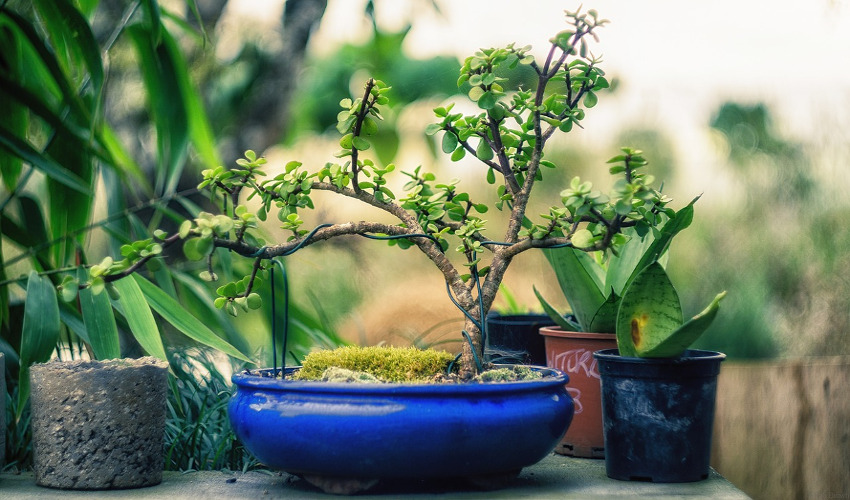Bonsai Basics for Beginners
Feb 19th 2021

Bonsai are undoubtedly charming, and these miniature trees have been enchanting and challenging arborists, plant lovers and artists for centuries. If you want to get started with your own tiny tree, however, you'd better start with the basics of bonsai to give your tree a healthy start for a long and beautiful life.
About Bonsai
Bonsai is the Japanese art of small, potted trees, but the practice originated from the Chinese art of penjing, or "tray scenery." The Chinese art involves not only plants, but also rocks, accents and other details that create entire scenes within the piece. When the Japanese adopted the art form, it became simplified to focus on the tree alone, a practice more in line with Zen Buddhism.
All bonsai are traditionally grown outdoors, and it is customary to keep the plant's proportion, shape and growth as close to natural forms as possible so the tree has a mature look despite its reduced size. Asymmetry and seeing the natural beauty of the plant rather than forcing it into a predictable pattern is a key to the art form of bonsai, and true bonsai trees trained and grown by master artisans are extremely valuable.
Today, the art of bonsai is practiced throughout the world, and there are many interpretations about what makes any particular plant appealing and successful in its miniature form. While the traditional aspects of this type of plant husbandry can be very specialized and exacting, there is plenty of flexibility within bonsai and anyone can try their hand at mastering a miniature tree in their own uniquely expressive way.
The Bonsai Basics You Need to Know
No matter how you envision your bonsai, there are basic principles and techniques that are essential to be sure you have a healthy, thriving specimen. It is wise to start by visiting a bonsai garden or exhibition to learn more about this art form, or research through books and other resources available about the history and practice of creating bonsai. When you are ready to get your hands in the dirt and a tree into a pot, however, you must begin with…
- Choosing the Appropriate Tree Type
Whether you choose to grow your bonsai indoors or outdoors, you must be certain it can adapt to the climate conditions where it will be kept. This includes sunlight levels, humidity and temperature changes. Tree varieties that are native to your area will be hardiest and best adapted to local conditions.
- Buying or Starting a Healthy Tree
You can start your bonsai from seed, but it may take 3-5 years before the seedling is large enough to begin training. If you prefer to get a tree that is already grown, you may be able to purchase one from a local nursery or bonsai supply store, or order one online. Be sure the tree is healthy and in good condition so it can withstand the stresses of its training and the restricted growth necessary to keep it miniaturized.
- Using the Best Tools
You will need several types of tools to properly work with your bonsai, including sheers, concave cutters, saws, root rakes and pliers. All your tools should be the appropriate size for working with tiny trees, and should be kept sharp and clean to minimize stress to the tree. You may wish to test several tool brands to be sure their grips are comfortable and you will have proper control for very precise movements as you use them.
- Proper Pruning
It takes precise work to properly prune a bonsai, and it is necessary to make certain types of cuts to minimize damage to the tree and ensure scars are nearly invisible when healed. Pruning is essential to keep the trees small and to help train the shape to mimic fully grown forms. Prune carefully and minimally to keep your bonsai in good shape.
- Wiring Wisely
Wiring is another common technique for shaping bonsai. Use only the proper wires of suitable strength, and be sure the wire is not wrapped so tightly that it begins to cut into the tree's bark, which can damage the tree and destroy its aesthetic lines. Ideally, wires should be wrapped so they are not visible when the tree is on display, or else they may detract from its natural appearance.
- Watering Appropriately
Because bonsai trees are rooted in very shallow pots, they often dry out more quickly and the trees need frequent watering to stay properly hydrated. Overwatering can quickly lead to root rot, however, which is the top killer of bonsai trees. Drainage holes in the pot are essential and can help ensure excess water flows away from the tree to keep it moist but not soaked.
- Fertilizing Appropriately
A bonsai tree cannot spread its roots far and wide to seek out nutrition in the surrounding soil, so regular fertilization will be necessary to nourish the tree. It is important to adjust a fertilizing schedule and application rates to account for the smaller size and slower growth of these trees, however, to keep the fertilizer from inadvertently burning delicate roots.
It can be very rewarding to cultivate, train and shape a beautiful bonsai, and this is one art form that every plant lover, gardener or horticulturist can easily indulge in. Once you've learned the basics of bonsai, you're ready to start your first tiny tree and learn how to create amazing beauty in the plants you care for.

